- Data & Statistics
Access Quick Stats (searchable database)
The Quick Stats Database is the most comprehensive tool for accessing agricultural data published by NASS. It allows you to customize your query by commodity, location, or time period.
Access Quick Stats Lite
Quick Stats Lite provides a more structured approach to get commonly requested statistics from our online database.
Explore Statistics
County Level Information
Geospatial Data & Interactive Maps
- Publications
Browse NASS Reports
- by Subject
- by Date (Reports Calendar)
- by Title/Release Day
- by Keyword
- Guide to Products and Services
Additional Reports
Historical Publications
- Archived Ag Census Reports (2002 and prior - published every 5 years)
- Annual Agricultural Statistics
- Statistical Bulletins (final estimates, 1987 to 2012
- Track Records: (crops, livestock, grain stocks)
- Trends 20th century
- Price Reactions (after crop or livestock reports)
Receive Reports by Email:
- Newsroom
News Releases
04/15/24 USDA NASS announces retirement of Administrator Hubert Hamer
03/28/24 United States hog inventory up 1%
03/28/24 US farmers expect to plant less corn and more soybean acres
03/26/24 USDA to host Data Users’ Meeting to gather public input on statistical programs
Read More News
ASB Notices
04/15/24 NASS appoints Lance Honig as new ASB Chair
04/09/24 NASS discontinues select 2024 data collection programs and reports
04/04/24 NASS announces program changes following five-year review
02/23/24 NASS Delays Cold Storage Data Release
12/19/23 NASS seeks public input during survey program review
Read More Notices
Videos
02/13/24 2022 Census of Agriculture Data Highlights
02/13/24 How to Find 2022 Census of Agriculture Data
02/13/24 2022 Census of Agriculture Data Release Event
07/16/21 What is a Farm?
08/05/20 The NASS Mission: We do it for you
View More Videos
ASB Briefings
04/17/24 National Hemp Report (April 2024)
04/11/24 Crop Production (April 2024)
03/28/24 Quarterly Hogs and Pigs (March 2024)
03/28/24 Grain Stocks, Prospective Plantings, Rice Stocks (March 2024)
03/08/24 Crop Production (March 2024)
View More Briefings
- Surveys
- Census
- About NASS
Structure and Organization
- Agency Overview
- NASS Biographies
- Organizational Chart
- Assistance to Other Organizations
- International Programs
- NASS Strategic Plan for FY 2022-2026
- USDA Strategic Goals
- NASS Climate Adaptation and Resilience Plan
Guiding Principles
- Mission and Core Values
- Keeping Data Safe
- Confidentiality Pledge
- Security Pledge
- Security Statement
- Statement of Commitment to Scientific Integrity
- Regulations Guiding NASS
- Information Quality
Civil Rights
- USDA and NASS Civil Rights Policy Statement
- Civil Rights Accountability Policy and Procedures
- No FEAR Act Notice
- No FEAR Act - NASS Data
-
REE Reasonable Accommodations and Personal Assistance Services
- NASS Disability Affirmative Action Plan
- How to File an EEO Complaint
- Contact information for NASS Civil Rights Office
Work at NASS
Education and Outreach
- Understanding Ag Statistics
- Data Users' Meetings
- Morris Hansen Lecture
- International Conference on Agricultural Statistics
History and Procedures
- Agricultural Statistics Board and Lockup
- Agricultural Statistics: A Historical Timeline
- The Story of U.S. Agricultural Estimates
- As We Recall: The Growth of Agricultural Estimates, 1933-1961
-
Safeguarding America's Agricultural Statistics Report and Video
- History of Ag Statistics
- Report Procedures
- An Evolving Statistical Service
- Fact Finders for Agriculture
- Hall of Fame
- Contact Us
Mailing Address:
USDA-NASS
1400 Independence Ave., SW
Washington, DC 20250Survey FAQs and Contact Us:
Access FAQs or submit a question.
Data Inquiries:
Hours: 7:30 a.m. - 4:00 p.m. Eastern Time
Monday - Friday, except federal holidays
Toll-Free: (800) 727-9540Media Inquiries:
Other USDA Inquiries:
Hours: 9:00 a.m. - 5:30 p.m. Eastern Time
Monday - Friday, except federal holidays
Toll-Free: (833) One-USDA
Email: askusda@usda.gov
Website: https://ask.usda.gov/s/Civil Rights Office:
June Turner, Director
Email: / Phone: (202) 720-8257Regional and State Field Offices:
Find contact information for Regional and State Field Offices
Ask a Specialist:
Have a specific question for one of our subject experts? Contact a specialist.
Web Content Publishing Schedule:
Section 207(f)(2) of the E-Government Act of 2002 requires federal agencies to develop an inventory of information to be published on their Web sites, establish a schedule for publishing information, make those schedules available for public comment, and post the schedules and priorities on the Web site.
- Help
Technical Issues
Surveys
2014 Agricultural Chemical Use Survey - Corn Highlights
May 2015 | No. 2015-1 | Download PDF Version
The 2014 Agricultural Chemical Use Survey collected data about fertilizer and pesticide use as well as pest management practices on acres planted to corn. NASS conducted the survey among corn producers in fifteen states that together accounted for 89 percent of the 90.6 million acres planted to corn in the United States in 2014: Illinois, Indiana, Iowa, Kansas, Kentucky, Michigan, Minnesota, Missouri, Nebraska, North Dakota, Ohio, Pennsylvania, South Dakota, Texas, and Wisconsin (Fig. 1).
Data are for the surveyed states for the 2014 crop year, the one-year period beginning after the 2013 harvest and ending after the 2014 harvest.
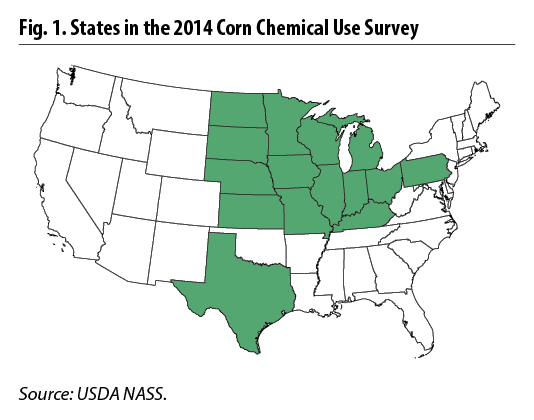
Fertilizer Use
Fertilizer refers to a soil-enriching input that contains one or more plant nutrients. The most widely applied nutrients to corn are nitrogen, phosphate, and potash. For the 2014 crop year, farmers applied nitrogen to 97 percent of planted acres, at an average rate of 144 pounds per acre, for a total of 11.2 billion pounds. They applied phosphate to 80 percent of planted acres and potash to 65 percent. (Table 1)
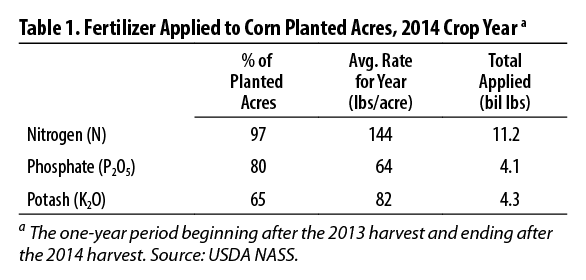
Pesticide Use
The pesticide active ingredients used on corn are classified in this report as herbicides (targeting weeds), insecticides (targeting insects), fungicides (targeting fungal disease), or other chemicals (targeting all other pests and other materials). Herbicides were used most extensively, applied to 97 percent of planted acres. Insecticides and fungicides were applied to 13 and 12 percent of planted acres, respectively. (Fig. 2)
Among herbicides, atrazine was the most widely used active ingredient (applied to 55 percent of planted acres), followed by glyphosate isopropylamine salt (38 percent) (Table 2).
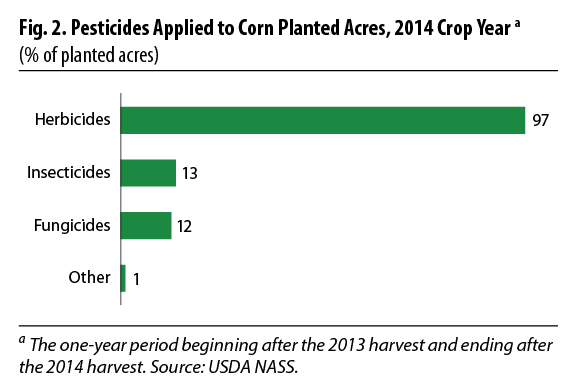
Pest Management Practices
The survey asked growers to report on the practices they used to manage pests, including weeds, insects, and diseases. Corn growers reported practices in four categories:
- Prevention practices involve actions to keep a pest population from infesting a crop or field.
- Avoidance practices use cultural measures to mitigate or eliminate detrimental effects of pests.
- Monitoring practices observe or detect pests through sampling, counting, or other forms of scouting.
- Suppression practices involve controlling or reducing existing pest populations to mitigate or eliminate crop damage.
Scouting for weeds was the most widely reported monitoring practice, used on 92 percent of corn planted acres. Among avoidance practices, crop rotation was practiced on 84 percent of planted acres. The most widely used prevention practice was no-till or minimum till (67 percent). Maintaining ground cover, mulching, or using other physical barriers was the most reported suppression practice (47 percent). (Table 3) These were also the top practice in each category in 2010, the last time NASS conducted a corn chemical use survey.
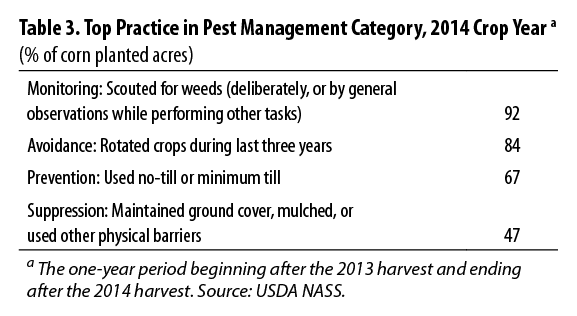
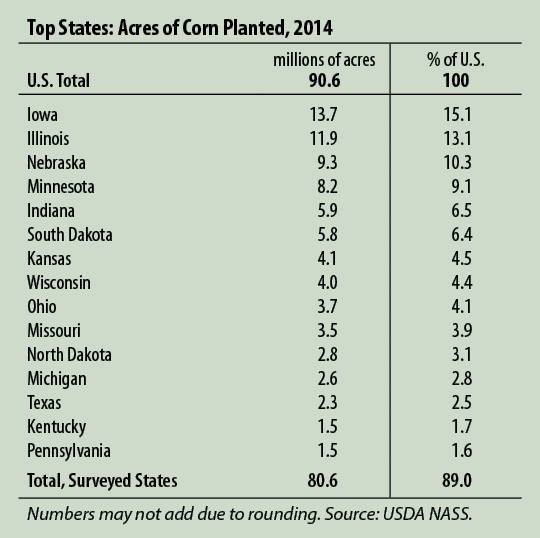
About the Survey
The Agricultural Chemical Use Program of USDA’s National Agricultural Statistics Service is the federal government’s official source of statistics about on-farm and post-harvest commercial fertilizer and pesticide use and pest management practices. NASS conducts agricultural chemical use surveys as part of the Agricultural Resource Management Survey. NASS conducted the corn chemical use survey in fall 2014.
Last Modified: 05/04/2018

